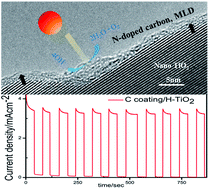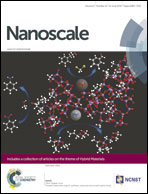Enhanced photoelectrochemical water splitting performance of TiO2 nanotube arrays coated with an ultrathin nitrogen-doped carbon film by molecular layer deposition†
Abstract
Vertically oriented TiO2 nanotube arrays (TNTAs) were conformally coated with an ultrathin nitrogen-doped (N-doped) carbon film via the carbonization of a polyimide film deposited by molecular layer deposition and simultaneously hydrogenated, thereby creating a core/shell nanostructure with a precisely controllable shell thickness. The core/shell nanostructure provides a larger heterojunction interface to substantially reduce the recombination of photogenerated electron–hole pairs, and hydrogenation enhances solar absorption of TNTAs. In addition, the N-doped carbon film coating acts as a high catalytic active surface for oxygen evolution reaction, as well as a protective film to prevent hydrogen-treated TiO2 nanotube oxidation by electrolyte or air. As a result, the N-doped carbon film coated TNTAs displayed remarkably improved photocurrent and photostability. The TNTAs with a N-doped carbon film of ∼1 nm produces a current density of 3.6 mA cm−2 at 0 V vs. Ag/AgCl under the illumination of AM 1.5G (100 mW cm−2), which represents one of the highest values achieved with modified TNTAs. Therefore, we propose that ultrathin N-doped carbon film coating on materials is a viable approach to enhance their PEC water splitting performance.


 Please wait while we load your content...
Please wait while we load your content...